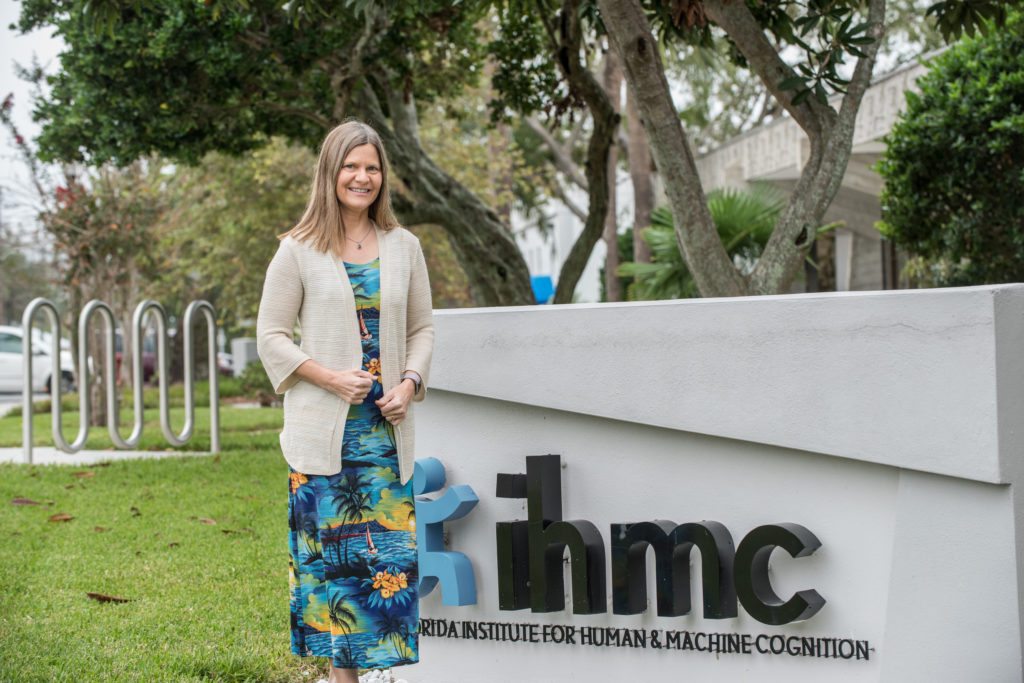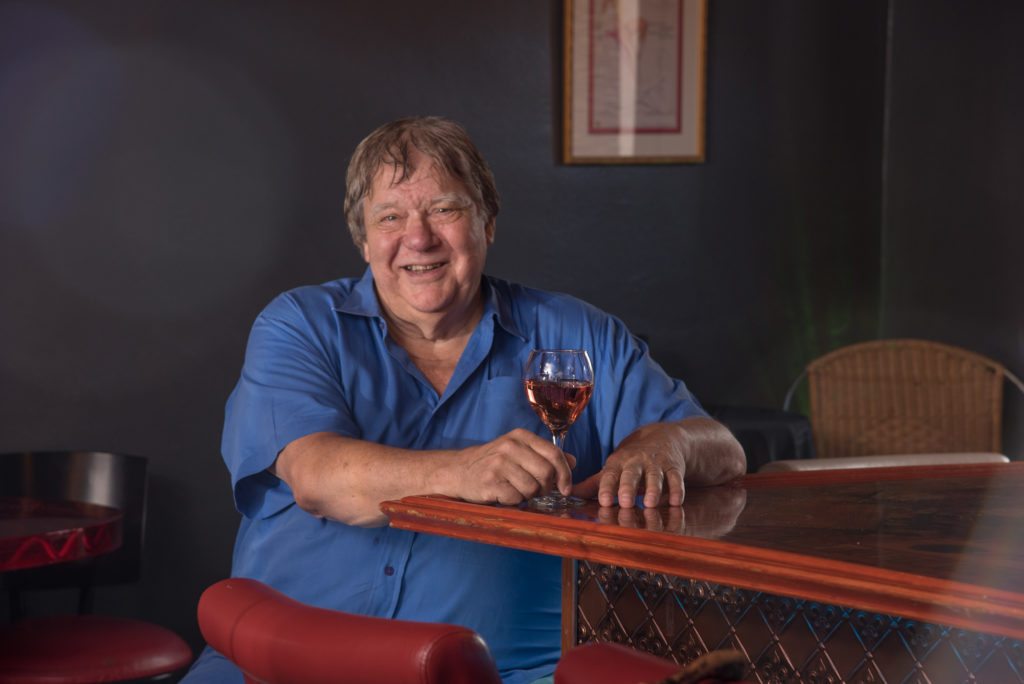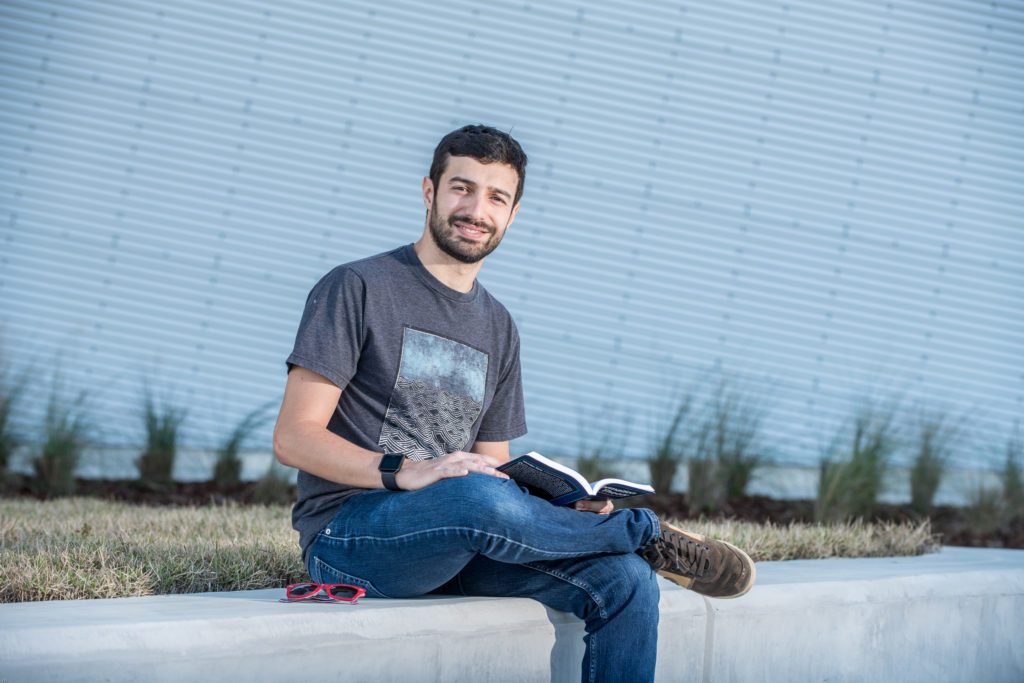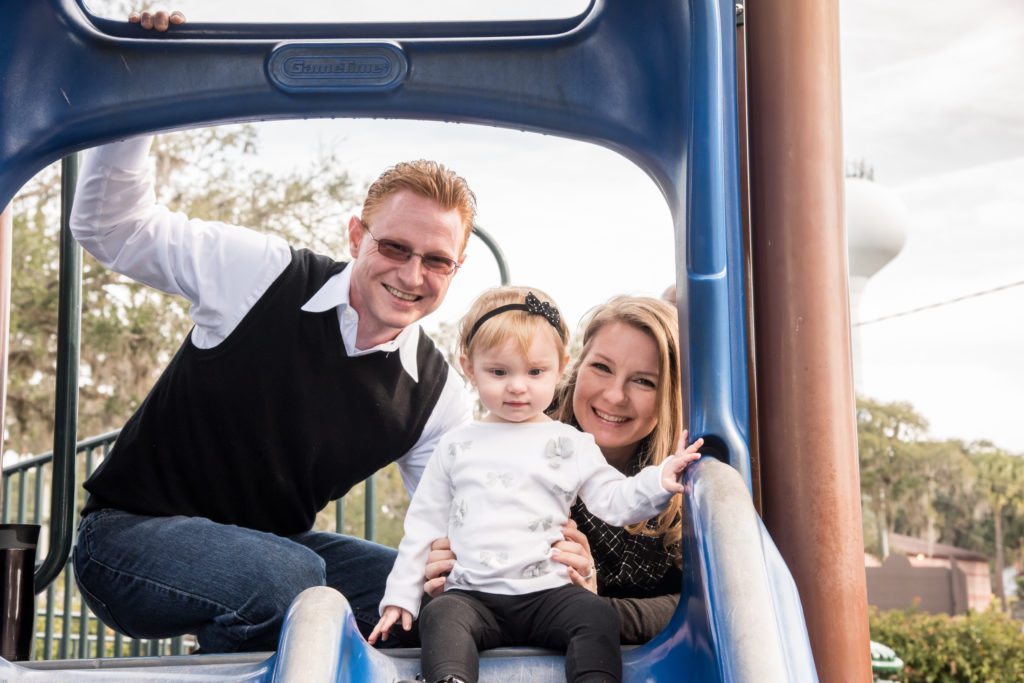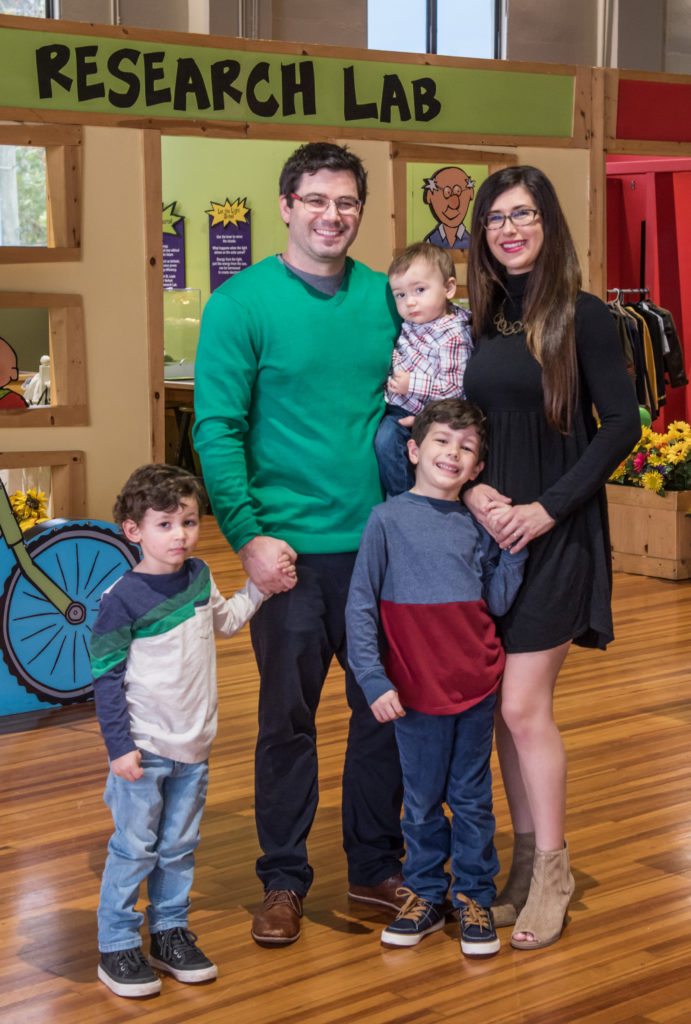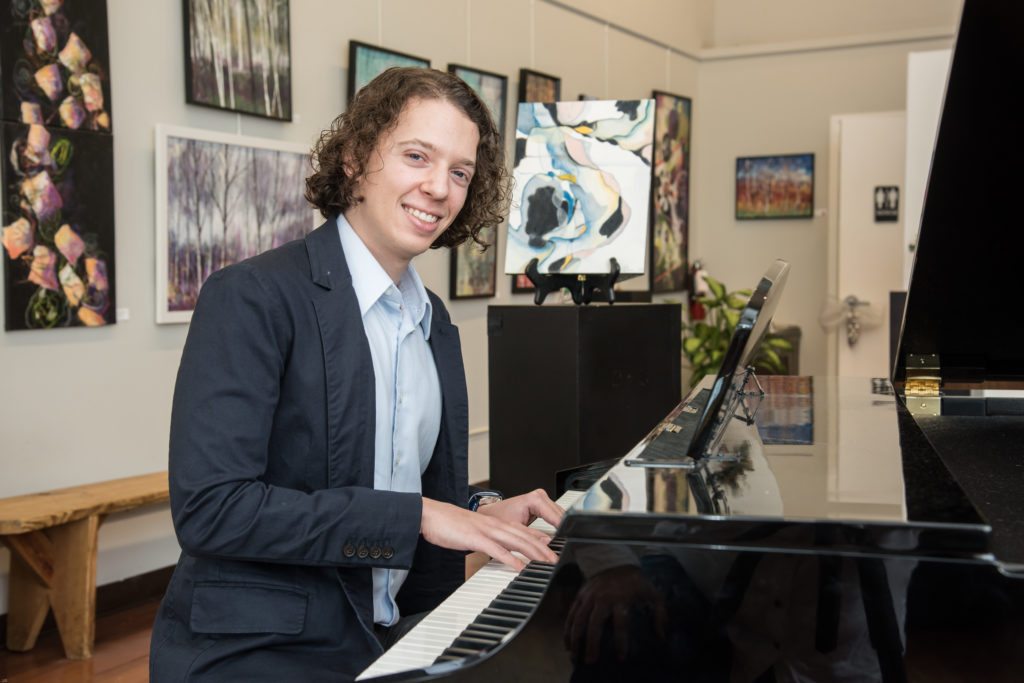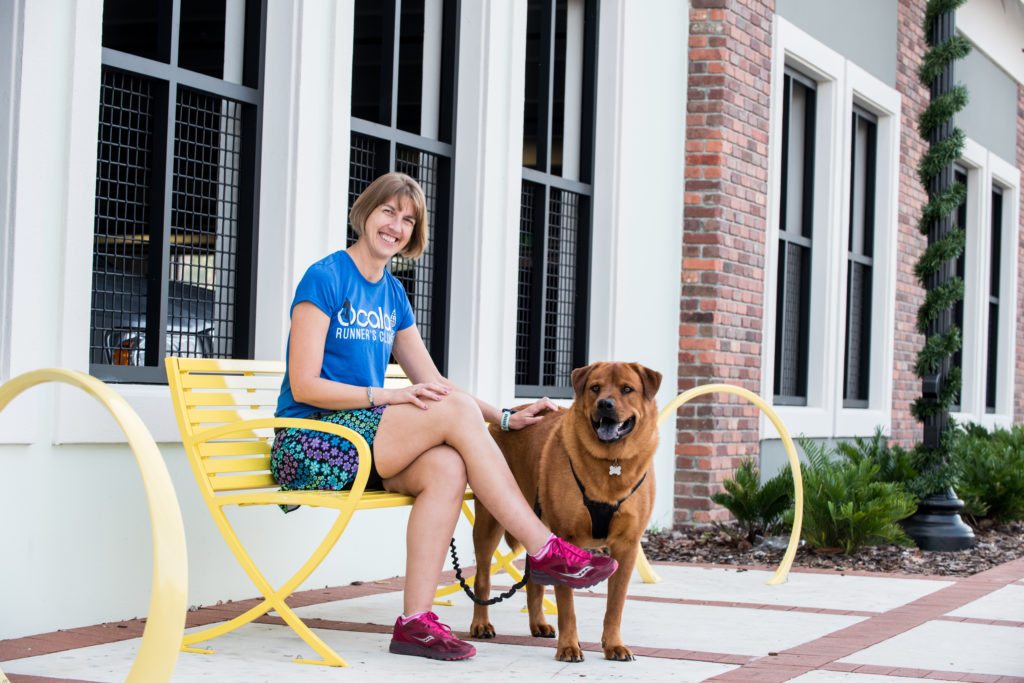The Institute for Human and Machine Cognition in downtown Ocala may look nondescript from the outside, but what’s inside is anything but ordinary.
Inside, a group of scientific researchers assembled from around the world collaborate on projects ranging from predicting cyber attacks to helping patients with amyotrophic lateral sclerosis (ALS) communicate with the world around them.
The complicated nature of their research requires exceptional minds from almost every scientific field. Here, in Ocala, they have come together under one roof to help solve some of the most pressing problems facing mankind today.
These gifted scientists and researchers walk amongst you every day. The next time you’re sitting down to lunch at your favorite restaurant, the man or woman sitting across from you could just be one of the brilliant minds from IHMC.
Here are Ocala’s faces of the future.
Bonnie Dorr
Associate Director and Senior Research Scientist
“Ken Ford brought me here to IHMC in 2014 and asked me to put together a research team,” says IHMC Associate Director Bonnie Dorr. “The research we perform here always has the human at the center; it is called human-centered computing, and it’s an effort to enhance mankind’s abilities through the collaborative efforts of machines and humans. We presently have 10 different projects the team is working on, and they are primarily funded through government contracts.”
Bonnie heads a 10-person team of scientists and researchers and leads the ELLIPSE project.
“Ocala was the perfect place for us because it is a centralized location that allows us to liaise with all the universities in the state,” she says. “We collaborate with several university studies, and that makes this an ideal site for us.”
Bonnie received her bachelor’s degree from Boston University and her masters and Ph.D. in computer science from the Massachusetts Institute of Technology. She co-founded the Computational Linguistics and Information Processing Laboratory at the University of Maryland and was a program manager at the Defense Advanced Research Projects Agency (DARPA), overseeing research in human language technology.
An avid runner and cyclist, Bonnie competes in track meets whenever possible and, many times, foregoes driving a vehicle, biking instead to work from her home.
“I used to be a marathoner, but I have switched to running track,” she says. “I joined a track team, and it’s awesome.”
Bonnie also loves to scuba dive and frequently visits the island of Bonaire off the coast of Venezuela to explore the coral reefs that surround the island.
“I love Bonaire. Everything there has to do with conservation, and the marine life is amazing,” she says. “We visit at least once a year.”
Yorick Wilks
Senior Research Scientist
Yorick was born in North London in 1939 to a working-class family.
“In those days, there were scholarships to good grammar schools that let children attend for free,” he says. “I attended a very good grammar school and then received a scholarship to attend Cambridge University. This opportunity changed my life and basically allowed me to escape my upbringing.”
While at Cambridge, Yorick studied math and philosophy, earning his Ph.D. in philosophy. While there, he became close friends with British linguist and philosopher Margaret Masterman and joined her Cambridge Language Research Unit, a group created to study machine translation and computational linguistics.
While working on his philosophy and computing doctorate thesis, Yorick left Cambridge and went to Los Angeles where he performed research funded by a one-year Air Force research grant.
“When the grant money ran out, I was still working on my thesis and needed money to pay the bills. I became a professional actor and supported myself by acting on television shows,” he says. “I did two seasons of Playboy After Dark shows and got to meet some rather big Hollywood stars. I became friends with the late Hugh Hefner, and I found him to be very insightful and intelligent. I was a young fellow in my 20s, and I found it all to be rather exciting.”
When not at IHMC, Yorick enjoys visiting some of downtown Ocala’s finest dining establishments.
“I like visiting the Ocala Wine Experience, Mark’s Prime Steakhouse or La Cuisine and talking with friends,” he says. “I also like the amateur acting groups here—I just might take on the right part if it came along.”
Giacomo Benincasa
Research Associate
Giacomo attended the University of Modena and Reggio Emilia in Italy, where he received his BS and MS in computer engineering. He was an exchange student at The University of Sheffield in England in the computer science department.
“I work on the DisService project. Its primary use is military, but it can be used anywhere,” he says. “It involves mesh networking. We use existing infrastructure such as cell towers and devices such as cell phones or radios to expand communications. Mesh networks allow different types of devices to piggyback signals like nodes in a network, with each device spreading the radio signal further than the one before it. It allows for local or regional network communication when the primary communication systems are inoperable, such as in a natural disaster or certain military situations. There are mesh networks out there now that are available to the public, such as goTenna. These networks are independent of ISPs, which allow for decentralized communications.”
Giacomo also works on the SocialSim project, which is led by Kristy Hollingshead.
“The SocialSim project allows us to perform social media behavior analysis based on online communications. We study how information spreads online,” he says. “The programs we create look for specific words, phrases or combination of words or phrases that can alert us to an impending cyber-attack.”
Giacomo has worked at IHMC for eight years.
“I love to play table tennis,” he says. “I belong to a club and play in tournaments. I also like to read or visit restaurants such as La Cuisine or Amrit Palace.”
Archna Bhatia
Research Associate
Archna performed her undergraduate studies in math at the University of Delhi and received her Ph.D. in linguistics from the University of Illinois at Urbana-Champaign.
She is the lead researcher on the DESIPHER project, working alongside collaborators Kristy Hollingshead and Bonnie Dorr.
“We are working in conjunction with the Tampa Veterans Administration Hospital to assist their patients suffering from ALS,” she says. “We are creating computer programs that can ‘listen’ to the voice of a person suffering from ALS and tell us two things: It can tell us exactly what they are saying, and it can tell us what level of progression the disease has reached. As this neuromuscular disease progresses, the person’s speech becomes slurred and less and less coherent. The patient’s mind is healthy, but their body is sick, and this can be very frustrating for them. It becomes very hard for us humans to understand them, but the computer’s speech recognition system we are designing will understand them and pass along their communication to us. Also, some of the tests the medical community uses to determine the stage of the disease are invasive and uncomfortable. If we can simply use speech to make this determination, then it will be much more comfortable for the patients. I find it very satisfying that we can help others in this way.”
Archna loves Ocala.
“I run quite a bit, l love to walk and I swim at the YMCA. Another great thing about Ocala is that it is right in the middle of the state, so you can drive either way to find the closest beach,” she says with a smile. “I love driving, and I love the ocean. I have explored the eastern coast of the state from north of Jacksonville all the way to Miami.”
Micah Clark
Research Scientist
Micah works with the Office of Naval Research in Washington, D.C. He has worked with the Navy since 2015. He received his undergraduate degree in computer science and philosophy and his Ph.D. in cognitive science from Rensselaer Polytechnic Institute in Troy, New York.
“I am a program officer who oversees a portfolio of investments in basic and applied research, primarily focused on artificial intelligence and cognitive systems for human-machine teaming,” he says. “I read and review scientific proposals in this field and determine which ideas are viable enough to receive funding. At any given time, I may fund between 40 and 60 different projects. My job is to make an educated decision on which problems are worth solving and which people and techniques I think can really make the best progress in solving them.”
Micah says that team interaction between humans and machines can be much more complicated than what it may first seem.
“Humans can learn on-the-fly from instruction and from watching others,” he says. “Presently, that is a very hard thing for a machine to do, but the present scientific goal is to create robot and machine teammates who can use skill acquisition and rapid learning through naturalistic interaction to do this very thing.”
Micah, his wife, Janelle, and their 1-year-old daughter, Abigail, enjoy the community aspect of Ocala.
“We are active in the Ocala Christian Church and love family time,” he says. “We love Ocala. It’s big enough that you’re not isolated or missing anything but small enough that you can really know the town. It’s such a beautiful place with plenty of green space, and it’s so quiet and peaceful. It’s a wonderful place to live.”
Adam Dalton
Research Associate
Adam has been with IHMC for five years. In conjunction with his work in the fields of natural language processing and cyber security, he attends the University of Florida where he is pursuing his Ph.D. in computer science.
Adam received his bachelor’s degree in computer science from McGill University in Canada and his master’s in modeling and simulation from UCF. Before coming to IHMC, Adam was employed by NASA where he worked at the Kennedy Space Center in human resources developing modeling and simulation to aid in the transition of the workforce when the shuttle and space station programs were being phased out and the program’s focus was being shifted to deep space exploration.
He then assisted in the design and development of the command and control aspects of NASA’s next generation Launch Control System. He then moved into his present position at IHMC.
“One of the projects I collaborate on is the ELLIPSE project, which deals with cyber security issues,” Adam says. “Our goal is to create programs that will detect certain online ‘signals’ that may indicate an upcoming cyber-attack, which would then enable the target of the attack to take steps to prevent it.”
Adam and his wife, Larissa, live a busy life with their three sons, Sam, 5, Ted, 3, and Alex, 1.
“Between my job here at IHMC, working on my Ph.D. and having three kids at home, I don’t have a lot of time for hobbies, but I do enjoy watching my children play sports, and I work out at CrossFit Iron Legion to help me stay in shape,” he says. “I also love to travel with my wife and children. We have a lot of friends and family across the United States, and we love to visit them and experience all the different towns and cities.”
Jena Hwang
Research Associate
Jena and her husband, Ryan Kooger, enjoy spending time with their two children, Paul, 2, and Liam, 1 month. She also loves cooking, riding her bike, walking… and crocheting.
“In college, a friend of mine was working on a granny-square blanket. I watched her and thought it was fascinating. Instead of asking her to show me how to do it, I simply imitated her. I picked up a crochet needle and taught myself how to crochet. I made a few scarves, but that just didn’t interest me, so I began to crochet small toys and unique patterns for friends as gifts. I’ve been doing it ever since. I make up most of my own patterns, and I really enjoy it. I’ve even thought about selling them as a business, but that would take a lot of energy, and I haven’t quite gotten there yet,” she says with a laugh.
Jena collaborates on the ELLIPSE and Communicating with Computers (CwC) projects.
“The CwC project has many facets, and my work is on the language side where I work with the most basic aspects of language,” she says. “This work will enable a machine to grasp the nuanced meaning of human language. My job provides the nuts and bolts that supports other programs in the project. All the information we gather, collate and develop on the language meaning will be used in ‘higher-level’ programs to enable a machine to understand human language and respond appropriately. For instance, if we say to a computer ‘Build a tall tower,’ through our work, the computer will understand just how tall tall really should be.”
Jena received her B.A. in computer science and B.S. in biochemistry from Calvin College in Grand Rapids, MI, and her master’s and Ph.D. in linguistics and cognitive science at the University of Colorado Boulder.
Ian Perera
Research Scientist
Ian loves to play video games, play the piano (anything from jazz to Chopin) and loves to paint abstract art.
“My job here at IHMC revolves around language and comprehension through language. What I love about music and art is that it doesn’t have to involve language at all,” he says. “I can express myself in both with just emotion and feeling. When painting, my goal is to defy interpretation by description. I want the person looking at my painting to experience it and not limit it with words.”
Ian obtained his BSE in digital media design from the University of Pennsylvania and his Ph.D. in computer science from the University of Rochester.
“While attending the University of Pennsylvania, I was selected for a summer research program at Johns Hopkins where undergraduate students were paired with graduate students and professors on different projects,” he says. “I realized then that research was something I was very interested in, and it was a much better fit for my talents than just programming video games.”
Ian has worked at IHMC for four years.
“I collaborate on a project called Communicating with Computers. Our goal is to have computers fully understand how we humans communicate with one another, thereby enabling us to communicate with them on that same level,” he says. “This communication with the machines will enable us to take our creative human ideas and combine them with the computer’s ability to process large amounts of data to collaborate and solve whatever problem we are attempting to solve. What is our goal, what is the system’s goal and how can we simultaneously use both of our strengths to attain those goals?”
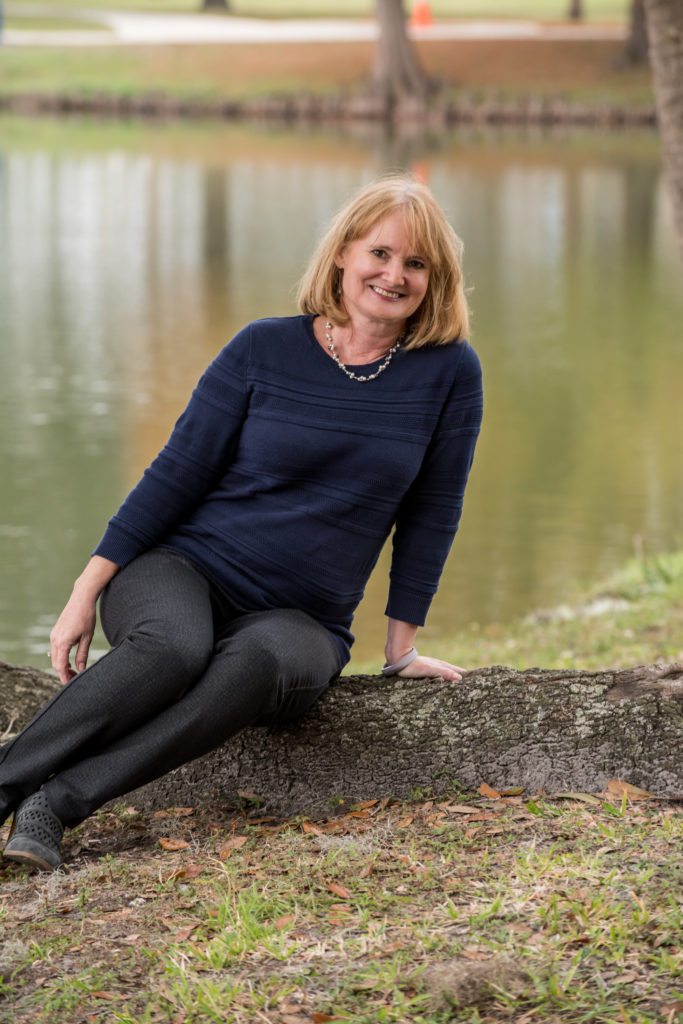
Ursula Schwuttke
Director of Educational Outreach
“I love the outdoors,” she says. “I like wildlife photography, traveling, canoeing. My husband, Dave, and I canoe all over the state and also when we travel. We also have a sailboat. Our longest sailing adventure to date is a one-month trip to Belize from Ft. Lauderdale.”
Ursula graduated magna cum laude from Brown University earning a degree in electrical engineering with an emphasis on semiconductor technology, and she obtained her Ph.D. in electrical engineering from the University of Southern California.
“At IHMC, I am the director of educational outreach,” she says. “We have created community outreach programs designed to give children an enthusiasm for learning and exploration in science and robotics. These programs are possible because of generous sponsors like Cox Communications, Lockheed Martin and Ron and Phyllis Ewers.
“Science Saturdays is a free program that meets on one Saturday each month during the school year from 9 to 10:30am and from 11am to 12:30pm. It is for students in grades three through five (but in December, we will start including some sixth-graders). We have a different presenter each month, and it’s a hands-on program that makes learning fun.
“We also offer Robotics Summer Camp at introductory and intermediate levels. These four-day camps are for students in grades seven through nine, and it introduces children to the world of robotics. Students work in teams using LEGO Mindstorms robots to overcome increasingly difficult challenges. This day camp lasts from 8:30am until 3:30pm and costs $150 per child. Costs are covered by local sponsors for low-income students.
“Any child interested in attending either program can call IHMC at (352) 387-3050 for more information or register online at IHMC.us.”
Ursula worked previously at NASA’s Jet Propulsion Laboratory in Pasadena, California and is a successful entrepreneur and businesswoman. She was awarded the Exceptional Achievement Medal by NASA for contributions to the space program.
Kristy Hollingshead Seitz
Research Scientist
“Many of my colleagues here identify as scientists, and some have identified that way since they were children. I do not identify that way—I am a bookworm. Language is my love and my passion,” Kristy says. “My undergraduate field of study at the University of Colorado Boulder was creative writing with a minor in programming. My father is an engineer, and my mother is a programmer and a meteorologist; they told me that it was fine with them if I wanted to be an author, but that I must take at least one computer science course. I did—and I loved it! I love puzzles, and programming is much like solving a puzzle.”
Kristy became a technical writer for IBM and while there discovered a job opening for a speech-to-speech translation programmer. She wanted the job, but it required additional education. She returned to school and earned her Ph.D. in computer science from Oregon Health and Science University. Following this, she worked for the Department of Defense prior to coming to IHMC.
Kristy is involved in several IHMC projects, including ELLIPSE and DESIPHER.
“DESIPHER is the project that brought me to IHMC,” she says. “With DESIPHER, we have a two-pronged approach to our research: Can we tell quantitatively the difference in the voice of a person with ALS and the voice of a person who doesn’t have the disease, and can we use that knowledge to adapt a speech recognition system such as Siri or Alexa so it can fully understand the speech of a person who has the disease as the disease progresses?”
Kristy is a member of the Ocala Runners Club, and she competes in triathlons. She has run five marathons and enjoys running the sidewalks of Ocala.

